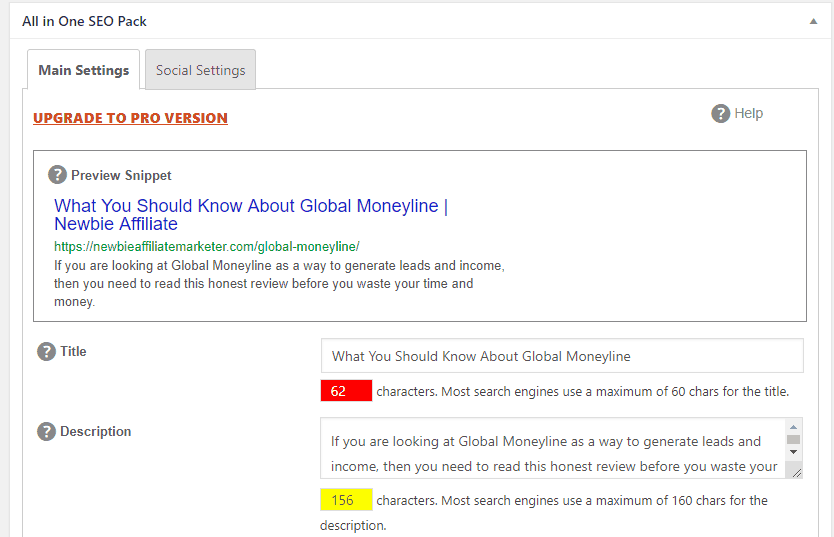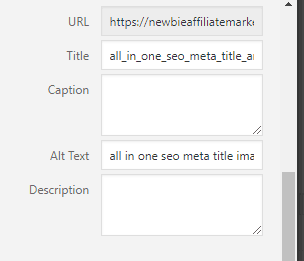 When you start mentioning SEO some people run a mile. They think it is a complicated thing when in truth it’s quite simple.
When you start mentioning SEO some people run a mile. They think it is a complicated thing when in truth it’s quite simple.
In this article, I am going to show you the SEO best practices checklist for your blog posts. By the time you have read through to the finish, you will feel much more confident about Search Engine Optimization (SEO) and how you can use it to gain higher rankings and more traffic.
Not got a blog yet? No problem.
Check out this article on how to build a blog from scratch with no experience needed.
You can start to build your blog for free and be up and running within just a few minutes. Then you can use these tasks on every blog post as you build your blog and your business.
I am going to break it down into six sections, so let’s get cracking with section one, Keywords.
Keywords
1. Search for Relevant Keywords
Finding good keywords will be your most important task. You are looking for what I call long-tail keywords that have low competition and that people are actually searching for.
More on how to find keywords that will rank high in the search engines in this article…
Using tools like Ubersuggest, AHreffs, and Jaaxy for keyword research can make life easier. You can even use the power of Google itself, by typing in a general keyword Google will then give you more suggestions of long-tailed keywords that people have searched for.
2. Include Keywords in an H1 Tag
Adding your chosen keywords to your blog title will in turn add an H1 tag (heading one) which is a must. If you can get your main keywords at the beginning of the title that would be more beneficial in Google’s eye. You can have it anywhere within the title but make sure that it reads and flows correctly.
3. Add to Your First Paragraph
It was once thought that you needed your keywords throughout your article, but recent reports have stated that having it once within the first paragraph or two is all you need. If you are trying to rank for a long-tail keyword make sure the whole keyword is in there in the correct order.
4. Use LSI Keywords
Latent semantic indexing (LSI) is a system search engines use to analyze the other words people use surrounding a given topic. LSI keywords are words and phrases with a high degree of correlation to your target topic. Google’s algorithm uses them to help determine the content quality and relevance to the search term.
Watch this video about Keyword research…
5. One Keyword Per Post
Do not try to add more than one main keyword to each post. Although in time your post will rank for many words and phrases, concentrate on just one. This will help the search engines decipher what your article is about and rank it accordingly.
6. Meta Title
Add your keyword to the meta title. Meta titles are what the search engine shows in the search engine. An optimal length for this is under 60 characters. Anything over this length will probably get cut off and not be read.
7. Meta Description
The same goes for the meta description as with the title it is shown by the search engines in their results.
To enable you to add both the meta title and description you will need to add a plugin to your WordPress site. Two great ones are All in One SEO and Yoast SEO. Both are free to add and will appear at the bottom underneath your post editor.

You can also copy the information to the social settings, that way when people share your content on social networks this information will show up.
Links
8.Internal Links
Add at least one internal link to another page within your blog. Be sure that the anchor text (the text you are linking from) is relevant to the page you are linking to. Avoid using click here, or something similar as your anchor text.
The more content you produce the more links you can add. Don’t forget to go back and update old posts too with new relevant links. This will add quality to your articles and enable you to get more pages views and longer retention time for each visitor.
9. External Link
Add at least one external link to your post. This will be a link to another website ideally a high authority site. Wikipedia is always a good one if you are not sure where to link to. Again make sure it’s relevant to your article, and when linking choose to open the link in a new window, that way your visitor will not leave your site and can carry on reading the article.
This makes it a better user experience for the reader too.
10. Link To Older Posts
Direct people to your older posts again use good anchor text for this, which will help when the search engines crawl your site. This will make for a better user experience which is a plus in the eyes of the search engines.
Your Website URL
11. Your URL
Have the main keyword phrase in your URL, ideally at the beginning. This is not always possible but as long as it features somewhere it will help.
12. Short Is Good
Keep your URL as short as you can, cut out any unnecessary words that bring nothing to the table in regards to SEO. Studies have shown using really long URL’s are less likely to rank high in the search engines, but not impossible though.
Image
 13. Image File Name
13. Image File Name
When you add an image to your post then change the image file name before you upload it. This also can be done with images that you download from royalty-free sites such as Unsplash or Pixabay.
14. Add ALT Text
Google is great but there is something that it can’t do and that’s read pictures, well unless we tell them what the image is about.
You can do this by adding a title in what is known as the alternative text (ALT Text for short). If you have more than one image on a post then don’t just stuff the same keywords in these areas. Use a good title of what the picture is about. Let’s face it if the picture has nothing to do with the post then why is it there in the first place.
Remember, you can also rank the image in the search engines too, I get quite a bit of traffic every month from images that are ranking on the first page of Google. These of course will be under the images tab on Google, not the main search. That would be too easy 🙂
15. Size Does Matter
Try and upload your images to the correct size that you want in your post. This will not only keep your media library tidy but when you load your post it will load quickly. There is nothing more annoying than a site that doesn’t load quickly most readers will just click away. And we don’t want that.
With more and more people viewing on mobile devices this has become even more vital. Having a slow page load speed will impact your results.
You can use an image optimization plugin such as Kraken which will compress the image as it is loaded into your article.
Content
16. Keep It Unique
You will get penalized by the search engines for having duplicate content, so never just copy and paste the text into your post. Make it as unique as you can and you will be rewarded for it.
By all means research from other blogs and articles but then make notes and always write from scratch so your content remains unique.
17. Focus On Quality
You want to make your post quality for your reader if they like what they see and read they will be back for more and most probably be telling others about it too. When you write pretend you are speaking to a friend. The reader will then feel that you are talking directly at them. This can take time to perfect but keep trying, the more you write the better you will become… 🙂
18. Does Word Count Matter?
I see this question all the time on forums and sites like Wealthy Affiliate. Does it matter how many words I write in my blog? The truth is if you are looking to rank on the first page of Google then you will need to write a similar length article, more if possible.
There was a study done recently by Backlinkio and MOZ about the optimum length of a blog post. I won’t bore you with all the details but in brief 500 words is a minimum when it comes to ranking the optimum ranking length is between 1,500 – 2,500 words to rank on page one (Phew currently at 1600 lol) anything over 2,500 then the rankings could start to drop slightly.
Don’t fill your article with nonrelevant information just to give it more words, Google’s algorithms are too clever. Quality over quantity will always win.
Of course, there are loads of other factors too so could you write 300 words and still rank possibly, but all I will say is hit the optimum level and you have a better chance.
Video
19. Add a Video
As most people know nowadays video is BIG, people love it. There are videos on Facebook, Twitter, Instagram, and Pinterest and that’s just a few sites, but YouTube is the oldest and largest video platform in the world… SHhhhh’s and if you didn’t know it is owned by Google.
With that in mind on some posts maybe embed a relevant YouTube video. Studies have shown this can help influence your rankings. I have used this tactic and I must admit it has worked for me.
After you have completed these tasks you can then let the search engines know that you have new content. Check out the video below on how to do this.
Wrapping Up
I trust you have found these tasks helpful, and when you add these to your blog posts they will make a difference to your rankings and your traffic. As we know Google and the other search engines are always updating and changing things but if you follow these hardcore principles then you should not go far wrong.
If you have found anything that works for you or doesn’t work then feel free to share by leaving a comment below. I would love to hear from you.


This article is really useful for a beginner like in the world of online business in area of blogging. This article is really informative and helpful and I have learnt something valuable that will guide me in my blogging career. I have bookmarked this page. Thanks for sharing this article.
Glad you found this list useful Brent
Nice post! As an affiliate marketer myself in pursuit of making money, I can defintley agree on the importance of keywords. They are hugely important for rankings and getting organic search traffic. Quite honestly, I think they are one of the most important parts of affiliate marketing, at least for a new website starting out. What is your favourite strategy for finding keywords?
Thanks for dropping by Kohl, I think you are right as keywords certainly have the power to make or break your business. I like to use Google’s keyword planner and Jaaxy keyword research tool. with this combination it seems to work for me.
Hey there,
I’ve really enjoyed reading this article as you’ve provided us with lots of useful information on SEO Practices. Whenever I do a Keyword Research, I look for keywords that are relevant to my niche that I selected, and also if it makes grammatical sense. In my opinion, I tend to think that targeting keywords with no grammatical sense can have a negative impact on your website rankings.
Thanks a lot for taking your precious time in writing this detailed post. Keep up the good work!
Thanks for stopping and commented keyword research is a vital part of any SEO best practices.
When you break down blogging and creating your own website it doesn’t sound that hard. I do have a couple questions though: Why only add one keyword per blog, if you have more wouldnt you rank higher faster?
Also when you’re doing a review do they have to be at least 500 words or more? One more, how on earth do you know if your content is quality? I might write something and think its really good quality but according to Google or other search engines it might not be, do you have any tips on creating good quality blogging?
Thanks for your questions. Firstly having just one main keyword phrase per article gives the search engines the sign of what you are wanting to rank for. There may of course be various variations of the keyword plus similar phrases and words within your blog post that they will rank you for. I just had a post rank for me keyword phrase but also at least 10 other phrases which included some or similar keywords. I would look at writing between 1000-2000 words per article. For more on the quality of your blogs read writing a good blog post this will help you. Trust this has answered your questions
Hi there, I have just homescreened your article. I have just started blogging and I hear alot about being a pro at search engines optimization strategies, but I have not come across a detailed way of doing it like you did in your article.
I am grateful that you took your time and energy to share such lucrative information. I have been practicing some of what you listed, but I have no idea about most of them.
Thanks Peace, if you are just starting out with blogging then there is a lot to learn. Try and learn something new everyday and then implement it. 🙂
I love reading blog posts on SEO as I am really working on building an SEO consultation business. I am eager to learn everything that I can on this journey as I know how important it would be in establishing myself as a leading SEO Consultant.
When it comes to Word count, I have seen some very long ass posts with over 3000 words rank on 1st and 2nd positions on google. Recently I saw a page with over 7500 words and I stopped reading at some point because,I mean, It was just too much unecceaary information expanded so much just to get out more words. Now,I was wondering how did that rank on the first page. What else would they have done right? Did I mention they had it stuffed with keyword?
There are of course many ranking factors that are taken into account by the search engines. I heard recently that an optimal length for a blog is between 1000-2000 words with the average ranking on page one of 1800. I try and hit these targets if possible.
Wow! Very good and detailed review, but in my own humble opinion I think the best place to learn great thing on affiliate marketing, website building, SEO and traffic pulling is on wealthy affiliate. I don’t really know any other website which is much resourced and packaged into a single website.
Thanks for the article. I would love to revisit for more articles like this.
Thanks Musbau, Totally agree about WA it is the best training platform on the internet. I say that from 9 years of experience too.
Your 19 SEO task to be completed before hitting the publish button is, in fact, a total ramification of what article or post search engine optimization should be. I am very familiar with most of these but your extra tips now reveal even more I did not know one should be doing.
A very insightful and valuable article this is and I am sure anyone reading this will say the same as well. Who knows where your next post will be pointing to and I for one cannot wait to read it.
Thank you for this great post!!
Thanks Richard glad you enjoyed the post
Hello, first and foremost I would like to commend you for this insightful post 19 task to complete before hitting publish on your blog post. For me personally, one of the things I have also learnt recently or noticed is that when I’m using keywords, I only use it in 2 paragraphs as to before when I try to put it in all. I still experience positive results with this and now you also just confirmed it in your article.
Thanks Seyi, yes you need to be careful of adding your target keywords too much, instead use other relevant words and phrases.
This is a great checklist, especially for beginners and I would like to add my two cents. Finding the right keyword is very important, but it’s not the be all and end all. I always go for 4 keywords or more within a key phrase. I find that that will give a better traction for LSI to form.
As for image sizes, I let the EWWW Optimizer plugin do the job. It will optimize all images with just a click of a button. Very easy and straightforward. For adding more word counts, consider getting people to comment on your articles once it’s published. That is also added to the length of a content with engagement factor that can rank your site higher on Google.
Thanks Cathy, I think you have added a full dollars worth with these comments. Indeed incorporating more than one keyword in a phrase is a great way to rank for different variations. I must admit I didn’t know about the comments being taken as part of the content count. Some brilliant points.
I am happy to see a complete listing and explanation of the value of all that goes into blogging. I used to think I was a good writer so I just went ahead and wrote my blogs. Later I learned about SEO and keywords and format and adding images etc. I must admit that it took me a while to get into using research tools. Before, I used to`just choose a word and get busy. Now I am learning that there is a science to blogging and results are measurable. This article gives me a total picture, so I not only know about these issues, but I also can put them in context. Thank you
I must admit I was probably the same until I was taught what you need to do to achieve good rankings in the search engines. Using a site like Wealthy Affiliate has helped tremendously with this.
This is indeed a lovely post. you have included everything I know and more than I know should be part of on-page SEO best practices. What is the difference between older post and internal link? I guess you are referring to the same thing. I have bookmarked this page and would want to always make reference to this. I hope you would find time to talk about off-page SEO in another post. Nice post .
Yes older posts and internal link within this article are the same thing, although you can of course link to a newer one as well. I do have another post planned for off page SEO and I may just link it to this one… LOL thanks for your comments
very nice content for seo
Indeed Rohit